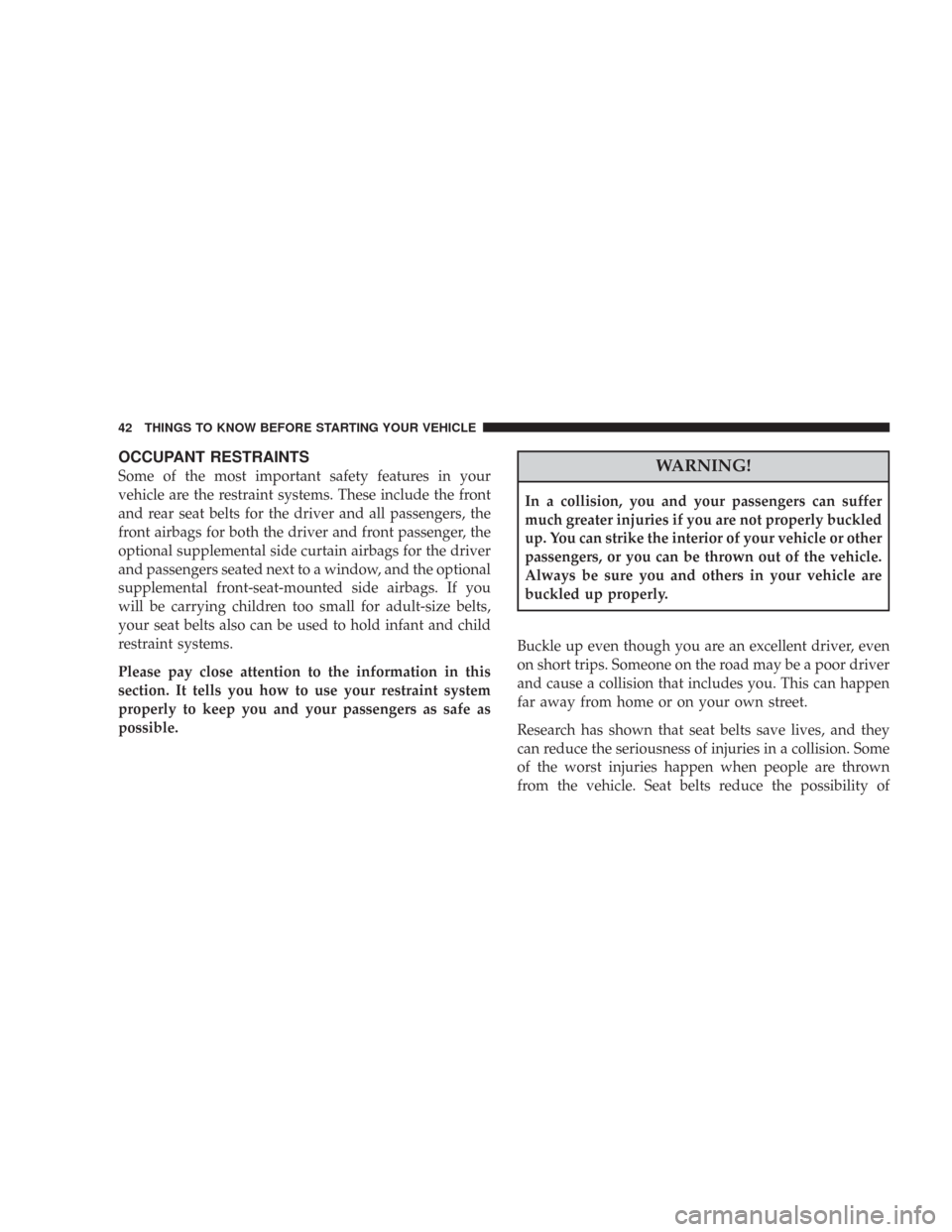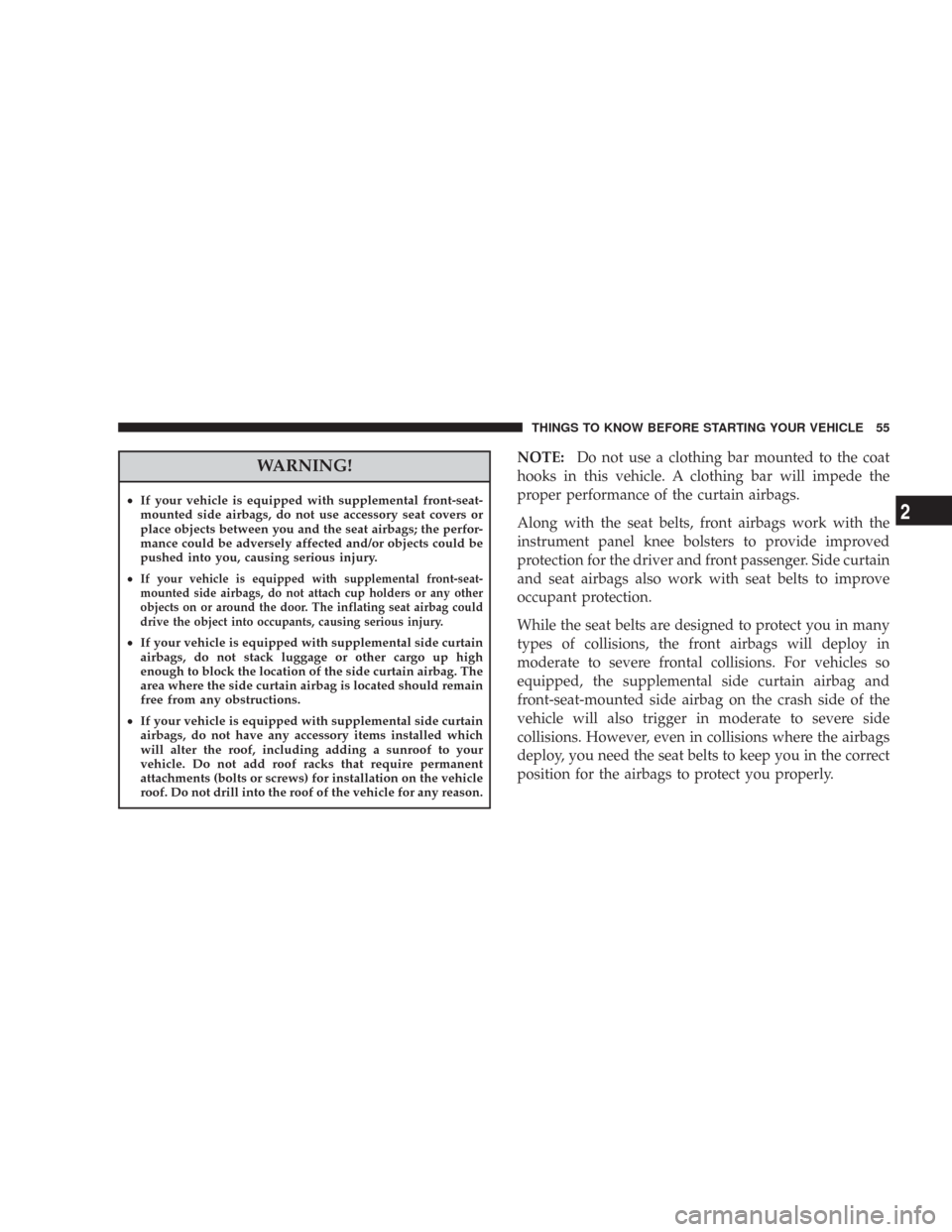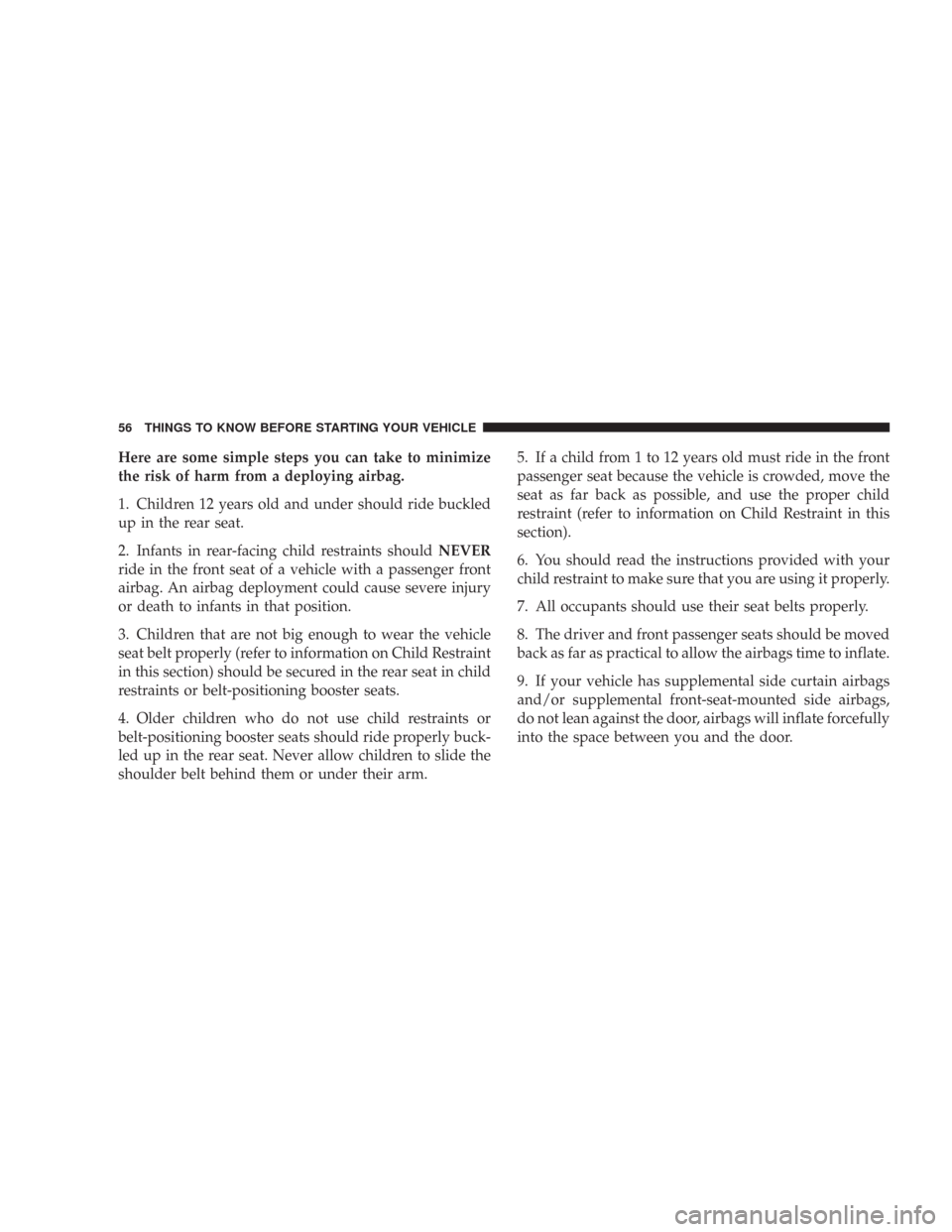Page 11 of 519
▫Driver And Front Passenger Supplemental
Restraint System (SRS) - Airbag............52
▫Event Data Recorder (EDR)...............65
▫Child Restraint........................67
�Engine Break-In Recommendations...........76
�Safety Tips............................77
▫Transporting Passengers.................77▫Lock Your Vehicle......................77
▫Exhaust Gas..........................78
▫Safety Checks You Should Make Inside
The Vehicle..........................79
▫Periodic Safety Checks You Should Make
Outside The Vehicle....................79
THINGS TO KNOW BEFORE STARTING YOUR VEHICLE 11
2
Page 42 of 519

OCCUPANT RESTRAINTS
Some of the most important safety features in your
vehicle are the restraint systems. These include the front
and rear seat belts for the driver and all passengers, the
front airbags for both the driver and front passenger, the
optional supplemental side curtain airbags for the driver
and passengers seated next to a window, and the optional
supplemental front-seat-mounted side airbags. If you
will be carrying children too small for adult-size belts,
your seat belts also can be used to hold infant and child
restraint systems.
Please pay close attention to the information in this
section. It tells you how to use your restraint system
properly to keep you and your passengers as safe as
possible.WARNING!
In a collision, you and your passengers can suffer
much greater injuries if you are not properly buckled
up. You can strike the interior of your vehicle or other
passengers, or you can be thrown out of the vehicle.
Always be sure you and others in your vehicle are
buckled up properly.
Buckle up even though you are an excellent driver, even
on short trips. Someone on the road may be a poor driver
and cause a collision that includes you. This can happen
far away from home or on your own street.
Research has shown that seat belts save lives, and they
can reduce the seriousness of injuries in a collision. Some
of the worst injuries happen when people are thrown
from the vehicle. Seat belts reduce the possibility of
42 THINGS TO KNOW BEFORE STARTING YOUR VEHICLE
Page 48 of 519

In the rear seat, move toward the center of the seat to
position the belt away from your neck.
Lap/Shoulder Belt Untwisting Procedure
Use the following procedure to untwist a twisted lap/
shoulder belt.
1. Position the latch plate as close as possible to the
anchor point.
2. At about 6 to 12 inches (15 to 30 cm) above the latch
plate, grasp and twist the belt webbing 180° to create a
fold that begins immediately above the latch plate.
3. Slide the latch plate upward over the folded webbing.
The folded webbing must enter the slot at the top of the
latch plate.
4. Continue to slide the latch plate up until it clears the
folded webbing.
Seat Belt Pretensioners
The seat belts for both front seating positions are
equipped with pretensioning devices that are designed to
remove any slack from the seat belts in the event of a
collision. These devices improve the performance of the
seat belt system by assuring that the belt is tight about the
occupant in a collision. Pretensioners work for all size
occupants, including those in child restraints.
NOTE:These devices are not a substitute for proper seat
belt placement by the occupant. The seat belt still must be
worn snugly and positioned properly.
The pretensioners are triggered by the Occupant Re-
straint Controller (ORC) (refer to information on Airbags
in this section). Like the front airbags, the pretensioners
are single use items. After a collision that is severe
enough to deploy the airbags and pretensioners, both
must be replaced.
48 THINGS TO KNOW BEFORE STARTING YOUR VEHICLE
Page 52 of 519
Driver and Front Passenger Supplemental
Restraint System (SRS) - Airbag
This vehicle has front airbags for both the driver and
front passenger as a supplement to the seat belt restraint
systems. The driver’s airbag is mounted in the center of
the steering wheel. The passenger’s front airbag is
mounted in the instrument panel, above the glove com-
partment. The words SRS AIRBAG are embossed on the
airbag covers.
NOTE:The front airbags are certified to the Federal
regulations that allow less forceful deployment.
Front Airbag Components
52 THINGS TO KNOW BEFORE STARTING YOUR VEHICLE
Page 53 of 519

The front airbags have a multistage inflator design. This
may allow the airbag to have different rates of inflation
that are based on collision severity.
WARNING!
•Do not put anything on or around the front airbag
covers or attempt to manually open them. You may
damage the airbags and you could be injured
because the airbags are no longer functional.
These protective covers for the airbag cushions are
designed to open only when the airbags are inflat-
ing.
•Do not drill, cut or tamper with the knee bolster in
any way.
•Do not mount any accessories to the knee bolster
such as alarm lights, stereos, citizens band radios
etc.This vehicle may also be equipped with supplemental
side curtain airbags to protect the driver and passengers
sitting next to a window and/or supplemental front-seat-
mounted side airbags.
If the vehicle is equipped with supplemental side curtain
airbags, they are located above the side windows. Their
covers are also labeled SRS AIRBAG.
THINGS TO KNOW BEFORE STARTING YOUR VEHICLE 53
2
Page 54 of 519
NOTE:Airbag covers may not be obvious in the interior
trim; but they will open to allow airbag deployment.
If the vehicle is equipped with supplemental front-seat-
mounted side airbags, they are marked with an SRS label
sewn into the outboard side of the seat.
Window Airbag
54 THINGS TO KNOW BEFORE STARTING YOUR VEHICLE
Page 55 of 519

WARNING!
•If your vehicle is equipped with supplemental front-seat-
mounted side airbags, do not use accessory seat covers or
place objects between you and the seat airbags; the perfor-
mance could be adversely affected and/or objects could be
pushed into you, causing serious injury.
•
If your vehicle is equipped with supplemental front-seat-
mounted side airbags, do not attach cup holders or any other
objects on or around the door. The inflating seat airbag could
drive the object into occupants, causing serious injury.
•If your vehicle is equipped with supplemental side curtain
airbags, do not stack luggage or other cargo up high
enough to block the location of the side curtain airbag. The
area where the side curtain airbag is located should remain
free from any obstructions.
•If your vehicle is equipped with supplemental side curtain
airbags, do not have any accessory items installed which
will alter the roof, including adding a sunroof to your
vehicle. Do not add roof racks that require permanent
attachments (bolts or screws) for installation on the vehicle
roof. Do not drill into the roof of the vehicle for any reason.
NOTE:Do not use a clothing bar mounted to the coat
hooks in this vehicle. A clothing bar will impede the
proper performance of the curtain airbags.
Along with the seat belts, front airbags work with the
instrument panel knee bolsters to provide improved
protection for the driver and front passenger. Side curtain
and seat airbags also work with seat belts to improve
occupant protection.
While the seat belts are designed to protect you in many
types of collisions, the front airbags will deploy in
moderate to severe frontal collisions. For vehicles so
equipped, the supplemental side curtain airbag and
front-seat-mounted side airbag on the crash side of the
vehicle will also trigger in moderate to severe side
collisions. However, even in collisions where the airbags
deploy, you need the seat belts to keep you in the correct
position for the airbags to protect you properly.
THINGS TO KNOW BEFORE STARTING YOUR VEHICLE 55
2
Page 56 of 519

Here are some simple steps you can take to minimize
the risk of harm from a deploying airbag.
1. Children 12 years old and under should ride buckled
up in the rear seat.
2. Infants in rear-facing child restraints shouldNEVER
ride in the front seat of a vehicle with a passenger front
airbag. An airbag deployment could cause severe injury
or death to infants in that position.
3. Children that are not big enough to wear the vehicle
seat belt properly (refer to information on Child Restraint
in this section) should be secured in the rear seat in child
restraints or belt-positioning booster seats.
4. Older children who do not use child restraints or
belt-positioning booster seats should ride properly buck-
led up in the rear seat. Never allow children to slide the
shoulder belt behind them or under their arm.5. If a child from 1 to 12 years old must ride in the front
passenger seat because the vehicle is crowded, move the
seat as far back as possible, and use the proper child
restraint (refer to information on Child Restraint in this
section).
6. You should read the instructions provided with your
child restraint to make sure that you are using it properly.
7. All occupants should use their seat belts properly.
8. The driver and front passenger seats should be moved
back as far as practical to allow the airbags time to inflate.
9. If your vehicle has supplemental side curtain airbags
and/or supplemental front-seat-mounted side airbags,
do not lean against the door, airbags will inflate forcefully
into the space between you and the door.
56 THINGS TO KNOW BEFORE STARTING YOUR VEHICLE